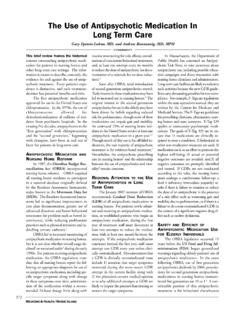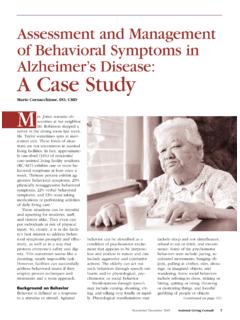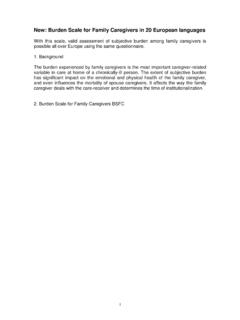Transcription of Mental health & mental illness Glossary of common …
1 Mental health & Mental illness Glossary of common terminology 2 Glossary of common terminology in Mental health & Mental illness The definitions in this document come from a variety of sources including Mental health charities Mind and Rethink, the National health Service (NHS), Mayo Clinic, and other informational online resources. Mind Your Head does not comprise of health care professionals and as such we do not aim to invent new definitions where they exist, nor to challenge existing definitions. As a Mental health awareness campaign we wish to compile an accessible resource that can be used by individuals to better under-stand the terminology used in the literature or other resources in order to improve their knowledge of Mental health and Mental illness .
2 We further hope that this Glossary helps reduce misconceptions about Mental health terminology . If you come across additional terms that are not included in this listing, or if you have any suggestions, please contact us by email: The MYH Team 3 A Abuse The illegal or excessive use of something (person, animal, object, ) that can generate damaging conse-quences. In a Mental health context you may often hear of sexual, drug or substance abuse. Acceptance Process of recognising a condition, a thought or emotion without attempting to change it or protest. Acceptance and Commitment Therapy (ACT) An empirically-based psychological intervention that uses a combination of acceptance and mindfulness strate-gies with commitment and behaviour-change strategies, to increase psychological flexibility.
3 The therapy helps people to understand unpleasant feelings, then learning not to act upon them, not avoiding situations where they are invoked and to move toward valued behaviour. Addiction A condition in which the body requires a drug in order to function without physical and psychological reactions to its absence. Addiction is often the outcome of tolerance and dependence and in severe cases may lead to some forms of abuse. There are different types of addiction. People can be, for instance, addicted to alcohol, smoking, drugs, sex, work, games, gambling, shopping, TV and internet. Affect A subjectively experienced feeling state. Affect is responsive to an emotional state that changes rapidly, where-as mood refers to a pervasive and sustained emotion.
4 common affects are euphoria, anger, and sadness. Alexitimia To not have words for emotions . Alexitimina therefore indicates the difficulty an individual might have in per-ceiving and identifying personal feelings and emotions; it often co-occurs with other disorders including a range of Mental illnesses. Alienation Estrangement, segregation or isolation that an individual can feel when the situation or group they are in is per-ceived as foreign, unpredictable, or unacceptable. American Psychiatric Association (APA) APA is the most important and largest psychiatric organisation in the world. The association publishes the Diag-nostic and Statistical Manual of Mental Disorders (DSM). See: Anhedonia Inability to derive pleasure from previously or usually pleasurable activities including eating, sex, hobbies, sports, social events, and family functions.
5 Anhedonia can manifest itself across a range of Mental health disorders in-cluding depression. Anorexia Nervosa Eating disorder characterised by trying to keep one s weight as low as possible, for example by starving or exer-cising excessively. 4 A Anxiety A Mental state and intense emotional response characterised by a feeling of preoccupation and fear, more or less intense and enduring. It can be connected to a specific stimulus that can be either internal or external. See Anxiety Disorders for link to Mental illness . Anxiety Disorders The class of Mental disorders containing any disorder in which anxiety is the primary feature. These disorders are also marked by physiological arousal, strong feelings of tension, and intense apprehension and excessive worry without apparent reason.
6 These symptoms can cause avoidance of everyday activities and cause clinically signifi-cant distress or impairment in social, occupational, or other important areas of functioning. Apathy Lack of feeling, emotion, interest, or concern. Assertiveness It consists in the ability to express personal emotions and opinions in a clear and efficient fashion, without offending or tackling the interlocutor. ( Mental health or psychiatric) Assessment A professional review of the client s needs. An assessment is done when services are first sought from an individ-ual and always before starting any type of treatment. The assessment normally identifies strengths and weak-nesses of the individual. After the assessment is carried out, the client and the professional decide what kind of treatment and supports, if any, are needed.
7 Attachment A dynamic group of attitudes and behaviours that contribute to the development of a specific bond between two individuals ( , caregiver-child, partners). Normally, the type of bond between a caregiver and a child influences the form that adult relationships might take in the future. Attention deficit hyperactivity disorder (ADHD) A group of behavioural symptoms that include inattentiveness, hyperactivity and impulsiveness. ADHD can occur in people of any intellectual ability. People with ADHD may also have additional problems, such as sleep and anx-iety disorders. Most cases are diagnosed in children between the ages of 6 and 12. Autism Also called autistic disorder; this, is a complex life-long developmental disability that presents itself in early child-hood, usually before age 3.
8 Autism prevents children and adolescents from interacting normally with other peo-ple and affects almost every aspect of their social and psychological development. 5 B Behavioural Activation This is a type of behaviour therapy for treating depression. It encourages clients to activate and develop skills and positive behaviours. The aim is to give the individual the opportunity to fill one s life with value and mean-ing, thanks to the positive reinforcement played by behaviours. Behavioural Therapy A type of treatment which focuses on changing unwanted behaviours through rewards, reinforcements, and de-sensitisation. Desensitisation, or Exposure Therapy, is a process of confronting something that arouses anxiety, discomfort, or fear and overcoming the unwanted responses.
9 Behavioural therapy often involves the coopera-tion of others, especially family and close friends, to reinforce a desired behaviour. Also see: Cognitive-Behavioural Therapy. Bipolar Disorder A severe mood disorder. Sufferers have pathological mood swings from depression where one feels very low and lethargic to mania where one feels very high and overactive. Diagnostic and Statistical Manual of Mental Disorders describes two types of bipolar disorder, type I and type II. In type I (formerly known as manic depres-sive disorder), there has been at least one full manic episode. However, people with this type may also experi-ence episodes of major depression. In type II disorder, periods of hypomania involve more attenuate (less se-vere) manic symptoms that alternate with at least one major depressive episode.
10 Body image One's sense of the self and one's body. Sometimes used in relation to certain eating and/or mood disorders. Borderline Personality Disorder A personality disorder with characteristics both from neurosis and psychosis. It implies extreme inability to pro-cess, tolerate and regulate emotions with subsequent difficulties and disruption in interpersonal relationships, behaviours, long-term planning, and the individual s sense of self-identity. Bulimia Nervosa An eating disorder characterised by the attempt to control their weight or remove guilt from eating by binge eating followed by measures to purge the body of the excess calories by deliberately being sick or using laxatives (medication to help empty their bowels).







